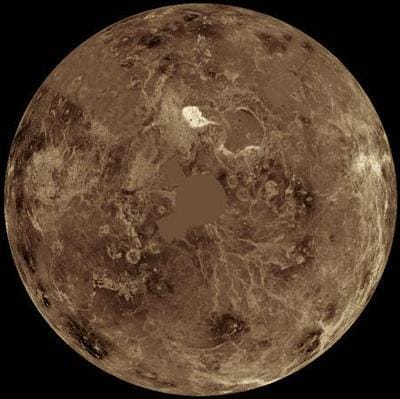金星简介(金星简介个人资料)
本文叙述内容如下:
金星的简介?
金星,1967年8月13日出生在辽宁沈阳,中国舞蹈家、脱口秀主持人。1978年加入沈阳军区前进歌舞团。1984年毕业于解放军艺术学院舞蹈系。2011年担任《舞林大会》评委。2012年主持个人脱口秀节目《金星撞火星》。2014年在《舞林争霸》中担任导师。2015年1月,主持个人脱口秀节目《金星秀》。2015年3月,在《超级演说家》担任导师。
太白金星介绍?
词语解释
太白金星--星名,即金星。太白金星又叫“长庚星”,“启明星”,每天傍晚天快黑时,西南方出现最早的一颗很亮的星,金星比太阳落得晚,所以叫长庚星,因为它出来的比太阳早,所以又叫启明星。中国古代称它为太白或太白金星。
太白金星又称白帝子,中国神话传说中的神。源于古代的星辰崇拜。太阳系中接近太阳的第二颗行星称“金星”。 《诗经·小雅·大东》: “东有启明,西有长庚。”
中文名
太白金星
又称
白帝子

含义
中国神话传说中的神
源于
古代的星辰崇拜
星系
太阳系
写金星的作文说明文?
天亮前后,东方地平线上有时会看到一颗特别明亮的“晨星”,人们叫它“启明星”;而在黄昏时分,西方余辉中有时会出现一颗非常明亮的“昏星”,人们叫它“长庚星”。这两颗星其实是一颗,即金星。金星是太阳系的八大行星之一,按离太阳由近及远的次序是第二颗。它是离地球最近的行星。
金星,在中国民间称它为“太白”或“太白金星”。古代神话中,“太白金星”是一位天神。古希腊人称金星为“阿佛洛狄忒”,是代表爱与美的女神。而罗马人把这位女神称为“维纳斯”,于是金星也被称为维纳斯了。
除太阳和月亮之外,金星是全天最亮的星,亮度最大时为-4.4等,比著名的天狼星(除太阳外全天最亮的恒星)还要亮14倍。金星没有卫星,因此金星上的夜空没有“月亮”,最亮的“星星”是地球。由于离太阳比较近,所以在金星上看太阳,太阳的大小比地球上看到的大1.5倍。
有人称金星是地球的孪生姐妹,确实,从结构上看,金星和地球有不少相似之处。金星的半径约为6073公里,只比地球半径小300公里,体积是地球的0.88倍,质量为地球的4/5;平均密度略小于地球。但两者的环境却有天壤之别:金星的表面温度很高,不存在液态水,加上极高的大气压力和严重缺氧等残酷的自然条件,金星不可能有任何生命存在。因此,金星和地球只是一对“貌合神离”的姐妹。

金星大气中,二氧化碳最多,占97%以上。同时还有一层厚达20到30公里的由浓硫酸组成的浓云。金星表面温度高达465至485度,大气压约为地球的90倍。
金星的自转很特别,自转方向与其它行星相反,是自西向东。因此,在金星上看,太阳是西升东落。它自转一周要243天,但金星上的一昼夜特别长, 相当于地球上的117天, 这就是说金星上的“一年”只有“两天”,一年中只能看到两次“日出”。金星绕太阳公转的轨道是一个很接近正圆的椭圆形,其公转速度约为每秒35公里,公转周期约为224.70天。 金星的公转轨道很接近于正圆,且与黄道面接近重合。其公转周期约为224.7日,但其自转周期却为243日,也就是说,金星的“一天”比“一年”还长。金星是太阳系内唯一逆向自转的大行星。另外它和水星一样,是太阳系中仅有的两个没有天然卫星的大行星。
金星周围有浓密的大气和云层。这些云层为金星表面罩上了一层神秘的面纱。只有借助于射电望远镜才能穿过这层大气,看到金星表面的本来面目。
金星星系介绍?
金星和地球一样是太阳的行星,排行老二,大小倒数第二,由于是地球的近邻,所以我们肉眼看到的金星又大又亮,正因为如此,古人給了它一个美好的名字金星。它看上去美丽,其实它的表面就如同太上老君的炼丹炉,炽热无比,并经常有火山爆发,气候也十分恶劣,人类根本无法接近,所以只是看上去很美丽。
能不能用英文介绍金星(五六百单词)?
Venus is the second planet in distance from the Sun. The planet was named for Venus, the Roman goddess of beauty. It also is the hottest planet in the solar system. Its surface has broiling temperatures that make rocks glow red under a crushing atmosphere. Venus is nearly the same size as Earth, but takes 243 days to rotate on its axis in the opposite direction. It also lacks a magnetic field and a moon. Why conditions on Venus and Earth are so different remains a major puzzle for planetary scientists. Venus circles the Sun at a distance of 108 million km, in a little over seven months.Except for the Sun and the Moon, Venus is the brightest object in the sky. It is often called the morning star when it appears in the east at sunrise, and the evening star when it is in the west at sunset.When viewed through a telescope, Venus exhibits its shape like the Moon. This is because Venus orbits closer to the Sun than Earth does. An observer on Earth can see Venus show from the side and from behind, as well as face-on—planets further away from the Sun than Earth only show a nearly fully lit, face-on view toward our planet. The phases of Venus were one of the proofs that the 17th-century astronomer Galileo used to show that Earth itself orbits the Sun. Venus’s full phase appears smaller and dimmer because it occurs when the planet is on the far side of the Sun from Earth. The phases and positions of Venus in the sky repeat every 1.6 yearsWhen the planet moves across the face of the Sun as seen from Earth, its transit are rare, occurring in pairs at intervals of a little more than a century. The most recent transit occurred in 2004. The second transit of the pair will be in 2012.Venus orbits the Sun at an average distance of about 108 million km .Venus is the nearest planet to Earth in distance at about 41 million km (25.4 million mi) away at its closest approach.Venus circles the Sun once every 224.7 days in a counterclockwise direction, the same direction as the other planets in the solar system. Its axis is nearly vertical and its orbit is nearly circular so Venus does not experience seasons the way Earth and Mars do because of their more tilted axes and more elliptical orbits. Venus rotates very slowly, once every 243 Earth days. Venus’s rotation is retrograde, which means that the planet turns from east to west as seen looking down on its north pole. Earth and most other planets turn from west to east.Venus is only slightly smaller and less dense than Earth. The planet’s surface gravity is nine-tenths as strong as surface gravity on Earth; an object that weighs 10 kg on Earth would weigh 9 kg on Venus.The extreme conditions on Venus make it highly unlikely that humans will ever set foot on the planet—there are no current plans for manned exploration. If humans ever reached Venus, they would weigh about the same as on Earth but would otherwise find a totally alien world requiring heavy protection from heat and pressure. The stifling atmosphere is so dense that even a slow breeze would feel like a tremendous gust. Although nighttime would last for over 58 days, it would not be dark—the entire rocky landscape would glow a dull red. Venus may be the closest thing in the solar system to the way humans have imagined hell.
怎么报名参加金星秀?
要报名参加金星秀,首先需要关注金星秀官方微博或官方网站,他们会发布报名信息。通常,报名需要填写个人基本信息,包括姓名、年龄、性别、联系方式等,并提交一段个人简介和表演视频。
在填写报名表时,要真实、准确地填写信息,并展示自己的特长和才艺。
报名截止后,工作人员会筛选报名者,并通过电话或邮件通知是否进入下一轮面试。如果通过初选,就会参加面试环节,面试时要展示自己的才艺和个人魅力。
最后,经过层层选拔,成功入选的选手将有机会登上金星秀的舞台,展示自己的才华。记得及时关注官方发布的报名信息,按要求准备好相关材料,祝你好运!
金星上全是金子吗?
不是的,金星上没有金子。

大约90%的金星表面是由不久之前才固化的玄武岩熔岩形成,当然也有极少量的陨石坑,金星的内部可能与地球是相似的:半径约3000千米的地核和由熔岩构成的地幔组成了金星的绝大部分。来自麦哲伦号的最近的数据表明金星的地壳比起原来所认为的更厚也更坚固。可以据此推测金星没有像地球那样的可移动的板块构造,但是却有大量的有规律的火山喷发遍布金星表面。金星上最古老的特征仅有8亿年历史,大多数地区都很年轻。那时广泛存在的山火擦洗了早期的表面,包括几个金星早期形成的大的环形山口金星的火山在隔离的地质热点依旧活跃。
关于金星的内部结构,还没有直接的资料,从理论推算得出,金星的内部结构和地球相似,有一个半径约3100公里的铁镍核,中间一层是主要由硅﹑氧﹑铁﹑镁等的化合物组成的“幔”,而外面一层是主要由硅化合物组成的很薄的“壳”。
科学家推测金星的内部构造可能和地球相似,依地球的构造推测,金星地函主要成分以橄榄石及辉石为主的矽酸盐,以及一层矽酸盐为主的地壳,中心则是由铁镍合金所组成的核心。
一个直径3000千米的铁质内核,熔化的石头为地幔填充大部分的星球。厚得多。就像地球,在地幔中的对流使得对表面产生了压力,但它由相对较小的许多区域减轻负荷,使得它不会像在地球,地壳在板块分界处被破坏。
金星简介:
金星(Venus)是太阳系中八大行星之一,按离太阳由近及远的次序,是第二颗,距离太阳0.725天文单位。它是离地球最近的行星(火星有时候会更近)。古罗马人称作维纳斯,中国古代称之为长庚、启明、太白或太白金星,古希腊神话中称为阿佛洛狄忒。

本文经授权由小花发布,转载联系作者并注明出处:https://www.jdezhil.cn/shenghuobaike/12515.html

 微信扫一扫
微信扫一扫